May 9, 2023
TICK PREVENTION
During the late spring through early fall, when ticks are most active, it is important to take precautions to avoid direct contact with them. Steer clear of wooded and brushy areas with high grass and leaves and stick to the center of trails while walking. To protect yourself further, wear long pants and long sleeves, as this will help keep ticks off your body.
To keep ticks on the outside of your clothing, tuck your shirts into your pants and your pants into your socks. Additionally, wearing light-colored clothing can make it easier to spot ticks.
When it comes to insect repellents, opt for those registered with the Environmental Protection Agency (EPA) and containing ingredients such as DEET, picaridin, IR3535, Oil of Lemon Eucalyptus (OLE), Paraomenthane-diol (PMD), or 2-undecanone. Apply repellent to exposed skin following the product instructions, and parents should apply it to their children while avoiding the hands, eyes, and mouth. Another option is treating clothing with permethrin-containing products. Clothing and gear like boots, pants, socks, and tents can be treated with products containing 0.5% permethrin, which remains protective through several washings. Alternatively, you can purchase clothing that is pre-treated with permethrin.
To ensure ticks are eliminated from clothing, wash them in hot water. Cold or medium-temperature water is not effective in killing ticks. If washing in hot water is not possible, tumble dry the clothes on low heat for 90 minutes or high heat for 60 minutes. For dry clothing, a tumble dry in a dryer on high heat for 10 minutes will suffice to kill ticks. If the clothes are damp, additional drying time may be needed to ensure they are warm and completely dry.
FINDING TICKS
After returning indoors, it is crucial to bathe or shower as soon as possible, ideally within two hours. This will help wash off any ticks that may be crawling on your body and make it easier to locate them. To ensure thoroughness, use a handheld or full-length mirror to conduct a comprehensive tick check, examining all parts of your body.
For parents, it’s important to check children for ticks in specific areas, including under the arms, in and around the ears, inside the belly button, behind the knees, between the legs, around the waist, and particularly in their hair.
Remember to inspect your gear and pets for ticks as well. Ticks can hitch a ride into your home on clothing and pets, potentially attaching to a person later on. Take the time to carefully examine your pets, outerwear, and day packs for any signs of ticks.
REMOVING TICKS
When removing a tick, utilize fine-tipped tweezers to grasp it as near to the skin’s surface as you can. Apply upward pressure steadily and evenly. Avoid twisting or jerking the tick, as this can result in the mouthparts breaking off and remaining in the skin. If the mouthparts do break off, carefully extract them using tweezers. In case you encounter difficulty in removing the mouthparts with clean tweezers, it is best to leave them be and allow the skin to heal naturally.
Once you have successfully removed the tick, it is important to clean both the bite area and your hands thoroughly. You can achieve this by using rubbing alcohol, an iodine scrub, or simply washing with soap and water.
Dispose of the live tick properly by submerging it in alcohol, placing it in a sealed bag or container, tightly wrapping it with tape, or flushing it down the toilet. It is crucial to avoid crushing the tick with your fingers.
If you experience a rash or fever within a few weeks after removing the tick, it is advisable to seek medical attention. Make sure to inform your healthcare provider about the recent tick bite, including the time it occurred and where you likely encountered the tick.

May 2, 2023
NO EXCUSES! HERE ARE THE TOP REASONS TO RIDE:
I’M OUT OF SHAPE
• Ride at an easy pace; before you know it, you will be in great shape.
• Ride your route on a weekend to find the easiest way to work.
• Consider an e-bike to supplement your ride.
I DON’T WANT PEOPLE TO WAIT ON ME
• We love to ride with others!
• If we’re out for training or a personal record, we’ll let you know. Otherwise, come ride with us!
• We’re already stopping to take photos.
IT TAKES TOO LONG
• The average commuter travels at 10 mph (and faster by e-bike)— the more you ride, the faster you will get.
• Did you know, trips of less than three miles will be quicker by bike than by car?
• Depending on traffic lights or road work, trips of five to seven miles may take the same time, or less, as by car.
IT’S TOO FAR
• Set up your car at work so you can ride to work and then take your car home, then alternating the next day.
• Combine riding and carpooling to shorten your commute.
• Ride to a coworker’s house or breakfast spot and carpool to work.
NO BIKE PARKING
• Look around for a storage area that’s not being utilized.
• Stash your bike in a covered, secure places such as a closet or even your office.
• Formally request that your employer provide bike parking or lock it up outside.
MY BIKE IS BEAT UP
• Tell a reputable bike shop like Tiny Corner Bike Shop that you are commuting and have them tune up your bike.
• If you can’t maintain your bike yourself, ask about a “frequent rider” discounted maintenance / tuneup program
• Make sure that your bike is reliable and in good working order before you start riding. YouTube is great!
NO SHOWERS
• Most commuters don’t shower at work; ride at an easy pace to stay cool and dry.
• Ride home at a fast pace if you want a workout; shower when you get there.
• The local gyms have showers, such as Wildwood Athletic Club in Oakland or the CARC in McHenry
I HAVE TO DRESS UP
• Keep multiple sets of clothing at work; rotate them on days you drive.
• Make a plan to ride on casual days at work.
• Pack clothes with you and change them at work; try rolling clothes instead of folding them.
IT’S RAINING
• Fenders for your bike and rain gear for your body will keep you dry.
• If you are at work, carpool to get home; ride home the next day.
• Drive if you don’t have the gear to ride comfortably in the rain.
THE ROADS AREN’T SAFE
• Join bike advocacy groups to join our work for safer streets; utilize the bike lanes.
• Obey traffic signs, ride on the right, signal turns, and stop at lights.
• Wear a helmet every time you ride.
I HAVE TO RUN ERRANDS
• Add accessories like a cargo rack, basket, or handlebar bag to add carrying capacity.
• Make sure that you have a lock to secure your bike while you are in a building.
• Allow extra time to get to scheduled appointments and find parking.
Connect with me and let’s ride! I’ll let you know where the group rides are happening or where the best rides are in Garrett County and Deep Creek Lake, MD.
FOR MORE INFORMATION ON HOW TO MAKE YOUR WORKPLACE MORE BICYCLE-FRIENDLY VISIT BIKELEAGUE.ORG/BUSINESSES
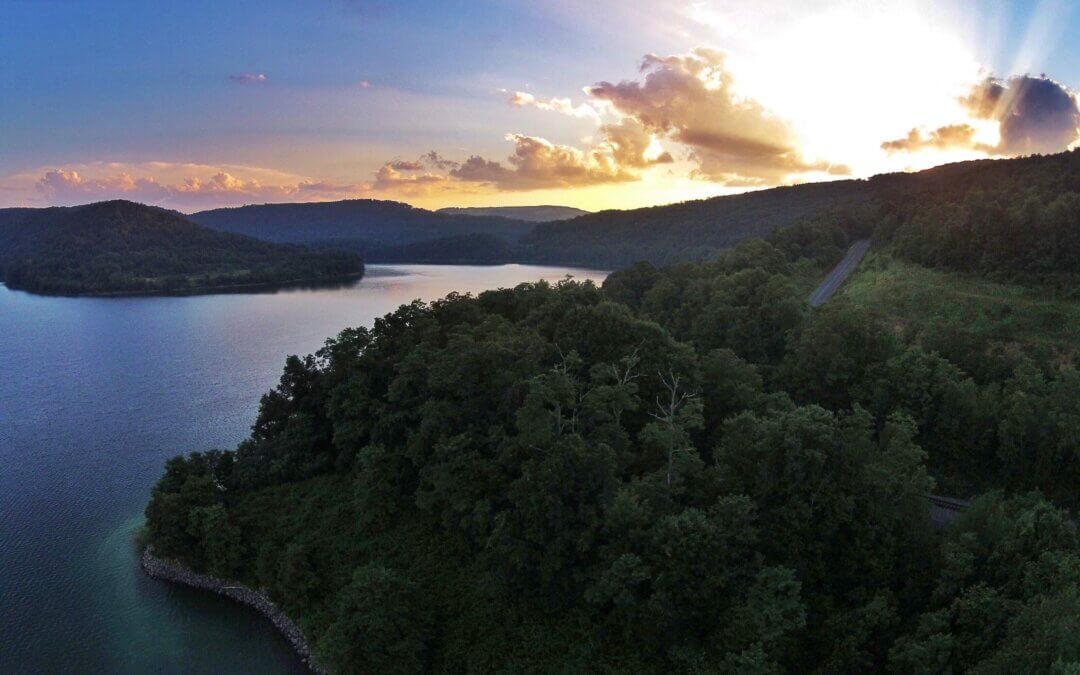
May 1, 2023
Jennings Randolph Lake is a man-made lake located on the North Branch Potomac River in Mineral County, West Virginia and Garrett County, Maryland. It was created in the 1980s as part of a federal flood control project, and it is named after former U.S. Senator Jennings Randolph, who was instrumental in securing funding for the project.
The idea for Jennings Randolph Lake dates back to the early 20th century when the North Branch Potomac River was prone to flooding. The first flood control study of the area was conducted in the 1930s, but it wasn’t until the 1970s that Congress authorized the construction of a dam and reservoir. The dam was completed in 1982, and the lake began to fill with water.
Jennings Randolph Lake serves several purposes, including flood control, water supply, and recreation. It is managed by the U.S. Army Corps of Engineers, which maintains the dam and surrounding lands. Today, the lake is a popular destination for boating, fishing, hiking, and camping. With its clear blue waters, picturesque surroundings, and numerous recreational opportunities, it is a popular destination for both locals and visitors alike.
Here, we’ll take a closer look at what makes Jennings Randolph Lake so special and why you should consider visiting:
One of the most notable features of Jennings Randolph Lake is its size. The lake spans over 950 acres, providing ample space for boating, fishing, swimming, and other water-based activities. Additionally, the lake is surrounded by lush forests and rolling hills, making it a great place to take in the natural beauty of the area.
The Boat Launch in Maryland can be found on Mt. Zion Road, accessible via Maryland State Route 135 on Backbone Mountain. Boasting a thirty-foot wide, 600-foot long concrete boat ramp complete with a floating pier system, this launch is a great choice for watercraft enthusiasts. A large, paved parking area is also available, with space for up to fifty cars and trailers, as well as a convenient comfort facility. The launch ramp and comfort station are both equipped with lighting for nighttime use. Please note that a Maryland service charge of $5.00 is required (paid via honor-box) for boat launching.
Fishing is a popular pastime at Jennings Randolph Lake, with anglers coming from all over to cast their lines in the clear waters. The lake is home to a variety of fish species, including g for largemouth bass, spotted bass, channel catfish, white crappie, walleye, saugeye, brown trout, bluegill and hybrid striped bass. There are also several fishing piers and boat ramps located throughout the lake, making it easy for visitors to access the best fishing spots.
For those who prefer to explore the lake by boat, Jennings Randolph Lake has several options. There are boat rentals available, as well as boat ramps for those who want to bring their own watercraft. Kayaking and canoeing are also popular activities on the lake, with plenty of opportunities to paddle around and take in the scenic views.
In addition to water-based activities, Jennings Randolph Lake also has several hiking trails and picnic areas for visitors to enjoy. The trails wind through the surrounding forests, providing plenty of opportunities to spot wildlife and take in the natural beauty of the area. The picnic areas are a great place to relax and enjoy a meal with family and friends.
Overall, Jennings Randolph Lake is a fantastic destination for anyone looking to escape the hustle and bustle of the busy Deep Creek Lake life and truly get away from it all!
(I’d love to see a photo of the infamous Waffle Rock if you get down to explore Jennings Randolph lake!)

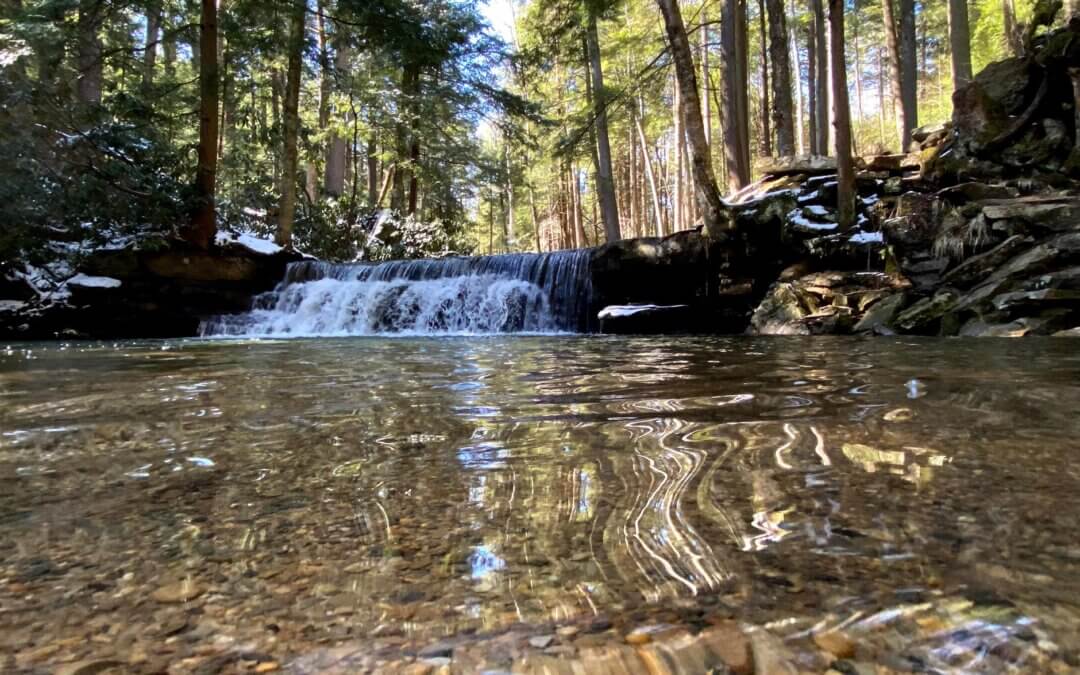
May 1, 2023
Located in western Maryland, Swallow Falls State Park is a popular destination for outdoor enthusiasts and nature lovers alike. The park is known for its stunning natural beauty, including towering hemlock trees, picturesque waterfalls, and rocky outcroppings. While many visitors to the park are familiar with the more famous Muddy Creek Falls and Swallow Falls, there is another waterfall in the park that is often overlooked: a small pour known as Tolliver Falls.
Tolliver Falls is a hidden gem in Swallow Falls State Park. Tucked away in a secluded corner of the park, the waterfall can be accessed via a short hiking trail that leads through a dense forest of hemlock trees and along igneous rocks known as diabase stacked up.
The waterfall itself is a sight to behold. At around 15 feet tall, it’s not as impressive as some of the other waterfalls in the park, but what it lacks in size it more than makes up for in beauty. The waterfall cascades down a series of rocky ledges into a shallow pool, creating a tranquil and picturesque setting that is perfect for nature lovers and photographers.
One of the best things about Tolliver Falls is that it is relatively unknown, compared to the other waterfalls in this park. Which means, often visitors will often have the waterfall all to themselves.
A hike in any of the four seasons will be great. In the winter, the shallow pool will freeze and Tolliver typically slows to a trickle. And, a little-known local’s secret is this is a great wading and swimming hole in those sticky summer months. Don’t forget the shoulder seasons where the light streams though the trees casting beautiful shadows and highlights to create a magical woodland.
Overall, despite its popularity among outdoor enthusiasts and nature lovers, the falls still retain a sense of serenity and peacefulness that makes it feel like a hidden gem. Whether you’re a local or a visitor, a short hike to Tolliver Falls is a great way to create new memories and capture the beauty of the natural world on your phone or camera.
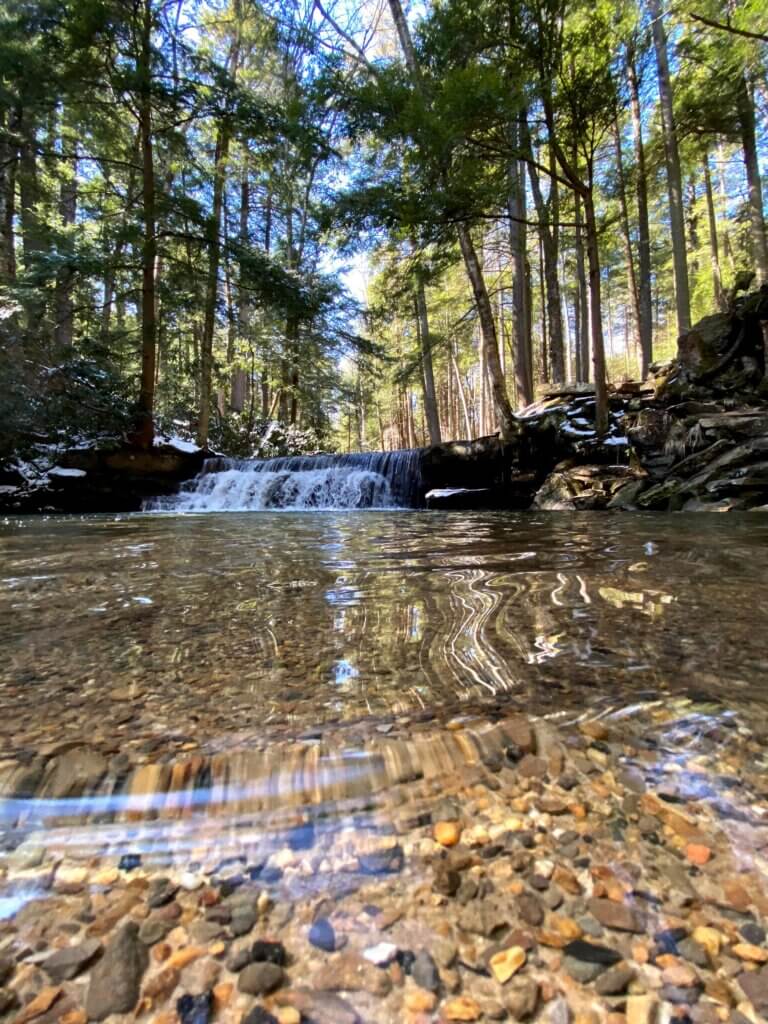
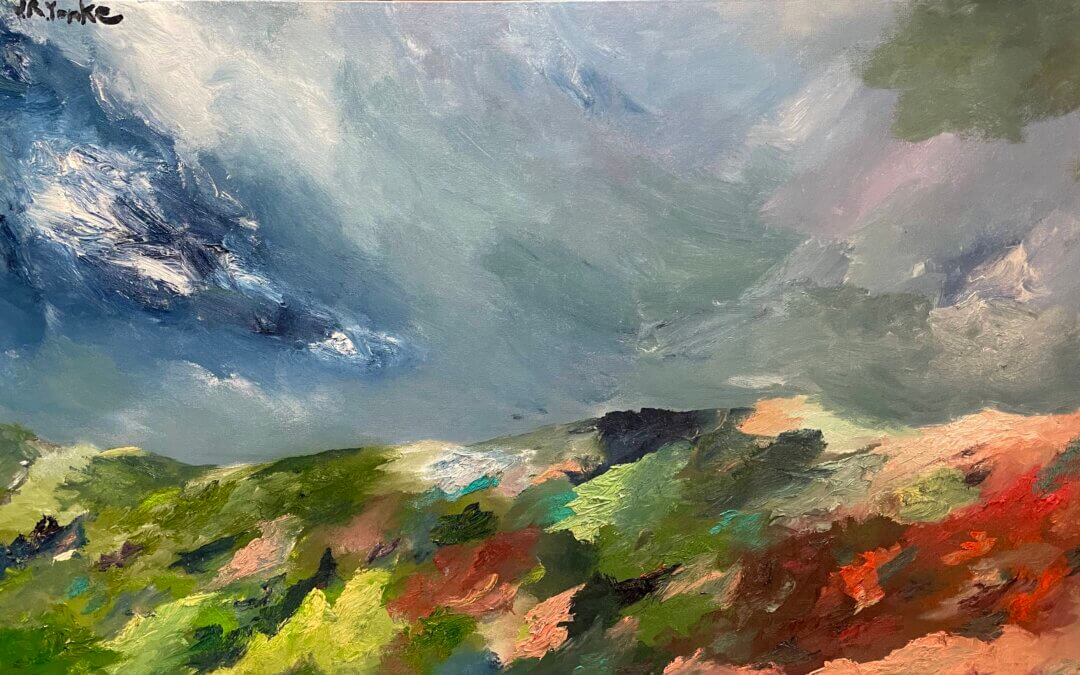
Apr 14, 2023
Joseph Yonke is a painter whose roots are deep in the mountains of western Maryland. His grandfather, celebrated watercolor artist Robert Yonke, has lived in the area now known as the Turkey Neck area of Deep Creek Lake for many years. The elder Yonke was instrumental in instilling a love of art in Joseph at a young age. As a child, Joseph spent his summers with Robert who taught him the intricacies of design, color, shapes, and how they coexist. These summers spent around the Deep Creek Lake area also exposed Joseph to the beauty of a rural landscape, which would later inspire many of his paintings.

While Joseph’s early works were primarily landscapes, he also began experimenting with large-scale abstract portraits. He enjoyed working with large canvases, as they allowed him more freedom to create without feeling confined. At the age of 9 or 10, he created his first abstract piece, which was a big geometric canvas. He later began incorporating faces into his abstract paintings.

Joseph is about to graduate college from Penn State (a family tradition) and pursue a career as a full-time artist. His preferred mediums are oil paint and acrylic, and he often uses bright pops of color in his pieces.
Joseph takes commissions and sells his original works. He has also worked with both private and non-private galleries, and his art can be found online and as part of installations under the name “Yonke Art”.
While he has moved away from the mountains, he still spends every summer in Garrett County, and he recently joined the Garrett County Arts Council.
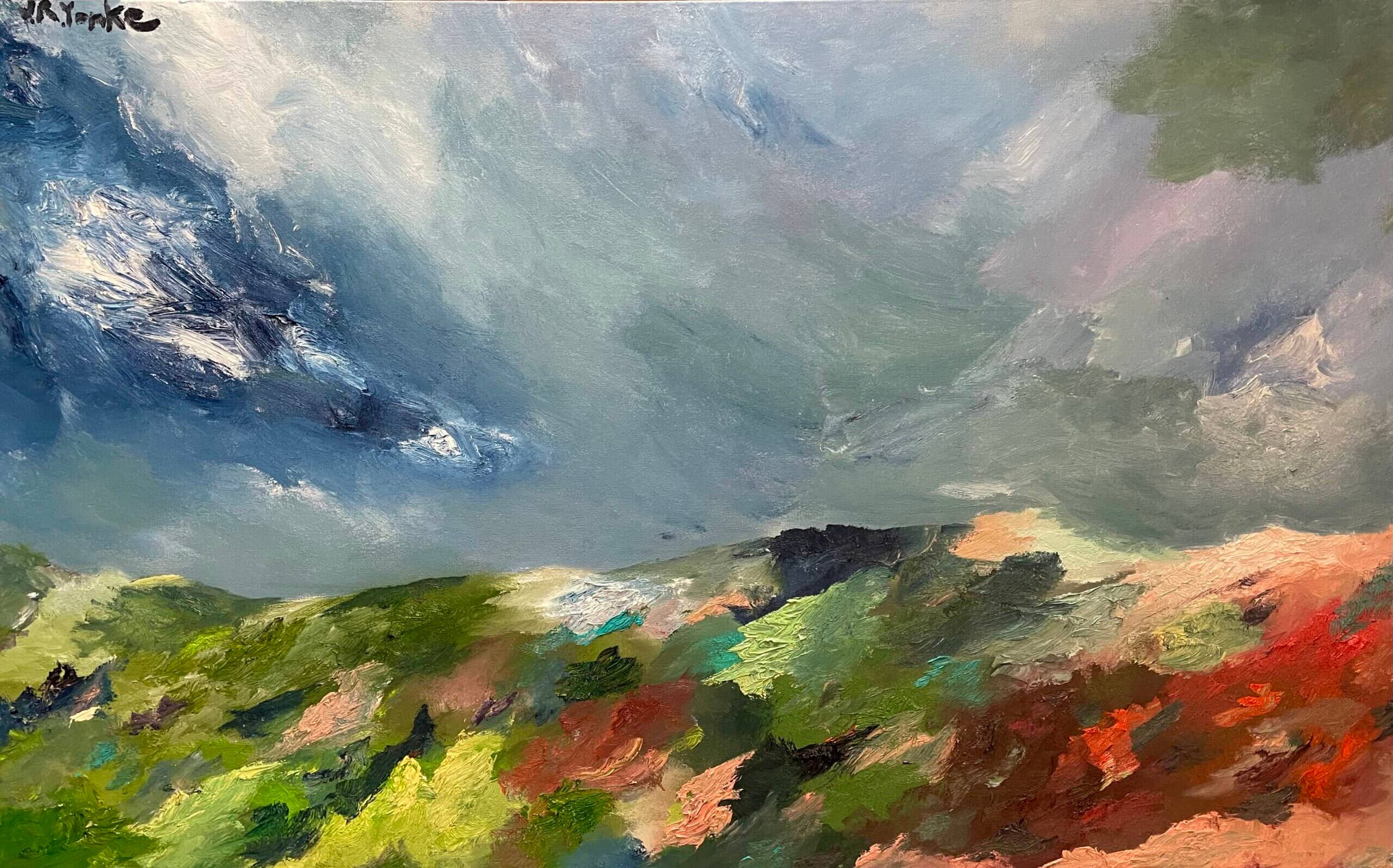
Overall, Joseph’s influences include George Condo and Willem DeKonig, two artists who have played a significant role in shaping his style. Today, Joseph’s art ranges from large-scale abstract portraits to local landscape-inspired pieces. He continues to study and experiment with different techniques to find what works best for each piece and his willingness to learn and grow as an artist has led him to find inspiration in the most unexpected places.
“I think people can make good art if they put in the due diligence to learn but there are also people who just make good work naturally. Mixing both hard work and natural talent are what, I think, make people really good!” said Joseph. “More times than not, if someone wants to be great at painting, I believe anyone can make it happen.”

Despite the intensity and pressure to produce his work, he finds it all worth it in the end.
Connect with Yonke Art online at https://yonkeart.com/ or on social media at https://www.instagram.com/jryonke/.

Apr 7, 2023
Originally published by Maryland Department of Motor Vehicles 2018
BACKGROUND
Riding a bicycle is great exercise, good for the environment, and just plain fun. Unfortunately, it can also be dangerous. Therefore, both bicyclists and motorists need to work together to be safe on the road. Bicycles are considered vehicles in Maryland, so bicyclists must devote as much attention to riding a bike as they would when operating a motor vehicle.
Equally as important, motorists must allow cyclists the same respect and caution they would allow another vehicle. Motorists can safely share the road with bicyclists by maintaining a (3) three-foot gap when passing a bicyclist, stopping for cyclists in crosswalks, and being alert when making turns. Wearing a helmet properly, being visible and being alert and aware of surroundings, are a few ways that bicyclists can be safer while riding. When we “share the road,” we all get to enjoy Maryland’s roadways safely.
MARYLAND’S BICYCLE SAFETY LAWS
By Maryland law, bicycles are vehicles. Bicyclists are authorized users of the roadway, and bicyclists have rights-of-way and the same duty to obey all traffic signals as motorists. But bicycles are less visible, quieter, and don’t have a protective barrier around them. Motorists should drive carefully near bicyclists; even a slight mistake can result in serious injury or even death.
Traffic Laws for Motorists
• The driver of a vehicle passing another vehicle, including a bicycle, must pass at a safe distance and leave plenty of space. The driver should be able to see the past vehicle in the rear-view mirror before returning to the original lane. After passing a driver must make sure they are clear of the bicyclist before making any turns.
• Drivers shall exercise due care to avoid colliding with any bicycle, Electric Personal Assistive Mobility Device (EPAMD), or motor scooter being ridden by a person.
• The driver of a vehicle must not pass any closer than three (3) feet to a bicycle or motor scooter if the bicycle is operated in a lawful manner. It is not lawful to ride against traffic.
• The bicycle has the right-of-way when the motor vehicle is making a turn, and motorists must yield to bicyclists. • Motorists must yield the right-of-way to bicyclists riding in bike lanes and shoulders when these vehicle operators are entering or crossing occupied bike lanes and shoulders.
• When riding on a sidewalk—where such riding is permitted—or a bike path, a bicyclist may ride in a crosswalk to continue their route. Motorists are required to yield right-of-way to a bicyclist operating lawfully in a crosswalk. Drivers must look for bicycles coming from both directions. (TR §21-101, §21-202, & §21-1103)
• A person may not throw any object at or in the direction of any person riding a bicycle, an EPAMD, or a motor scooter.
• A person may not open the door of any motor vehicle with intent to strike, injure, or interfere with any person riding a bicycle, an EPAMD, or a motor scooter.
• Failing to yield right-of-way to a bicyclist, resulting in a crash in which the bicyclist is seriously injured, can result in a $1,000 fine and three points on a driving record.
2018 Maryland Bicycle Safety Program Area Brief 4 Traffic Laws for Bicyclists
• Maryland’s traffic laws apply to bicycles and motor scooters. (TR§21-1202)
• A bicycle may not carry a passenger unless it is specifically designed for and equipped with a seat for each passenger. (TR§21-1203)
• Bicycles, motor scooters, and EPAMDs are not permitted on any roads where the speed limit is more than 50 miles per hour (MPH) or higher. (TR§21-1205.1)
• A person riding a bicycle shall ride as close to the right side of the road as practicable and safe, except when:
o Making or attempting to make a left turn;
o Operating on a one-way street;
o Passing a stopped or slower moving vehicle;
o Avoiding pedestrians or road hazards;
o The right lane is a right turn only lane; or
o Operating in a lane that is too narrow for a bicycle to travel safely side-by-side within the lane (TR§21-1205).
• Where there is a bike lane, a person must use those and not ride a bicycle or motor scooter in the roadway except: (TR§21-1205.1)
o If passing safely cannot be done within the bike lane or shoulder;
o When preparing for a left turn;
o To avoid hazards; or
o When the bike lane is also a right-turn or merge lane.
• Persons riding a bicycle or motor scooter may not cling to a vehicle on the roadway. (TR§21-124)
• A motor scooter may not be operated at a speed in excess of 30 MPH. (TR§21-1205.1)
• An EPAMD may not be operated at a speed in excess of 15 MPH. (TR§21-1205.1)
• A person cannot carry anything that prevents them from keeping both hands on the handlebars or that interferes with the view or balance of their bicycle, motor scooter, or EPAMD. (TR§21- 1206)
• A bicycle, motor scooter, or EPAMD may not be secured to a fire hydrant; a pole, meter, or device in a bus or taxi-loading zone; a pole, meter, or device within 25 feet of an intersection; or where it would obstruct or impede traffic. (TR§21-1206)
• A person may not ride a bicycle, motor scooter, or EPAMD while wearing a headset or earplugs that cover both ears. (TR§21-12010)
2018 Maryland Bicycle Safety Program Area Brief 5
Helmets
• Helmets are required for everyone under the age of 16, including passengers, who ride their bicycles on the road, bicycle paths, or any public property. (TR§21-1207.1)
• Helmets are also required for everyone under the age of 16 who is riding on a scooter or on inline skates. (TR§21-1207.2)
• The helmets must meet or exceed the standards of the American National Standards Institute, the Snell Memorial Foundation, or the American Society for Testing and Materials. (TR§21- 1207.1)
Required Equipment
• A lamp is required on the front of a bicycle or motor scooter if the bicycle or motor scooter is used on a highway when people and vehicles are not clearly visible at 1,000 feet. (TR§21-1207)
• A red reflector on the rear is required if the bicycle or motor scooter is used on a highway when people and vehicles are not clearly visible at 1,000 feet. (TR§21-1207)
• A bicycle or motor scooter may be equipped with a bell or other audible device, but not a siren or whistle. (TR§21-1207)
• A bicycle or motor scooter must be equipped with a brake. (TR§21-1207)
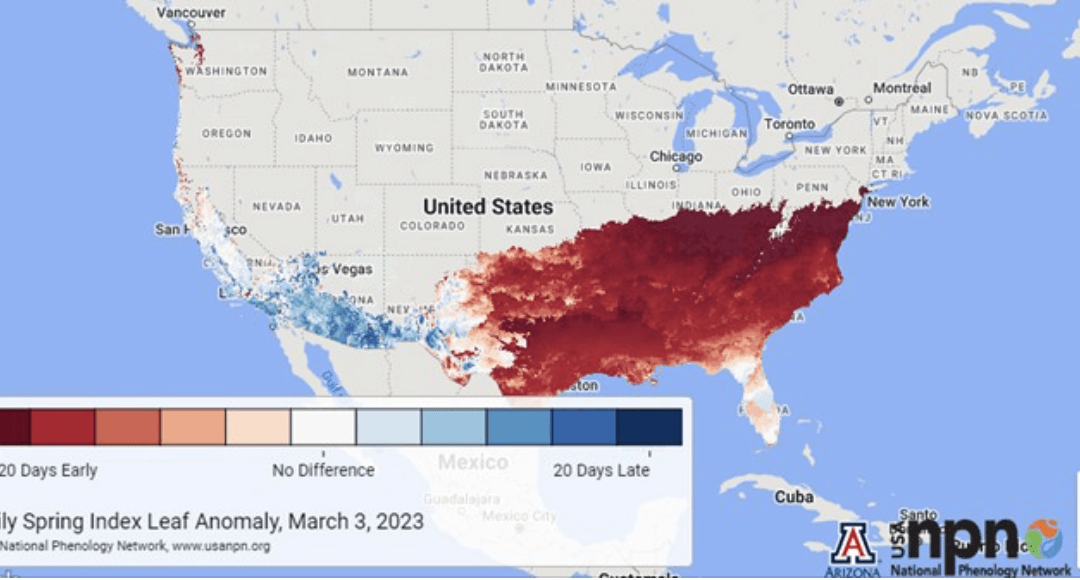
Mar 7, 2023
Originally published by Maryland Department of Natural Resources- Wildlife & Heritage Service
In life, as in comedy, timing is everything. The study of the timing of the cycles of life – when plant buds burst, when frogs start to sing, or butterflies emerge from winter cover – is called phenology. Our native plants and animals have evolved alongside one another, so their timing is synchronized. But does phenology change? You bet! Even renowned naturalist Henry David Thoreau noted plant emergence and flowering times at his cabin on Walden Pond in the 1850s (and other people have continued that effort, creating a really long data set). There are cool community science projects out there in which you can help track phenological phenomena around the world. One is the USA National Phenology Network (USA NPN).
USA NPN uses information provided by professionals AND community scientists like YOU to track these changes. Visit USA NPN, https://tinyurl.com/38vb44a8, to find out when spring is coming to your neck of the woods. And join the Nature’s Notebook phenology project and be the next Thoreau!
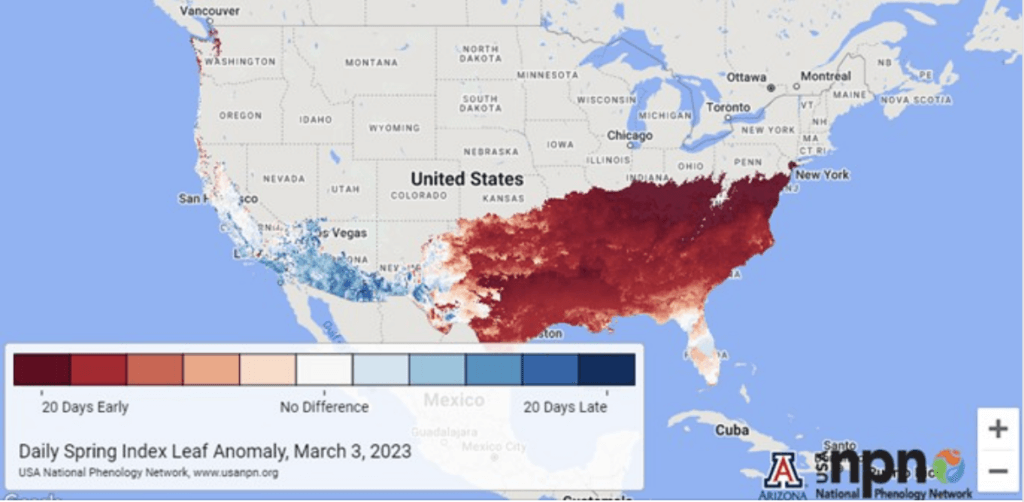
Mar 7, 2023
A DRAFT version of the GCPS Blueprint Implementation Plan is now available for review on the website: www.gcps.net/blueprint.
This document is a continuous work in progress, will have ongoing updates regularly, and reflects progress through March 6, 2023. Stakeholders may begin viewing the document and submitting a survey response for each pillar of the plan. Survey links may be found directly under the document or under each respective pillar section.
Additionally, responses in general to the GCPS Blueprint Implementation Plan that do not pertain to a specific pillar may be emailed to the Blueprint Coordinator instead, at blueprint@gcps.net.
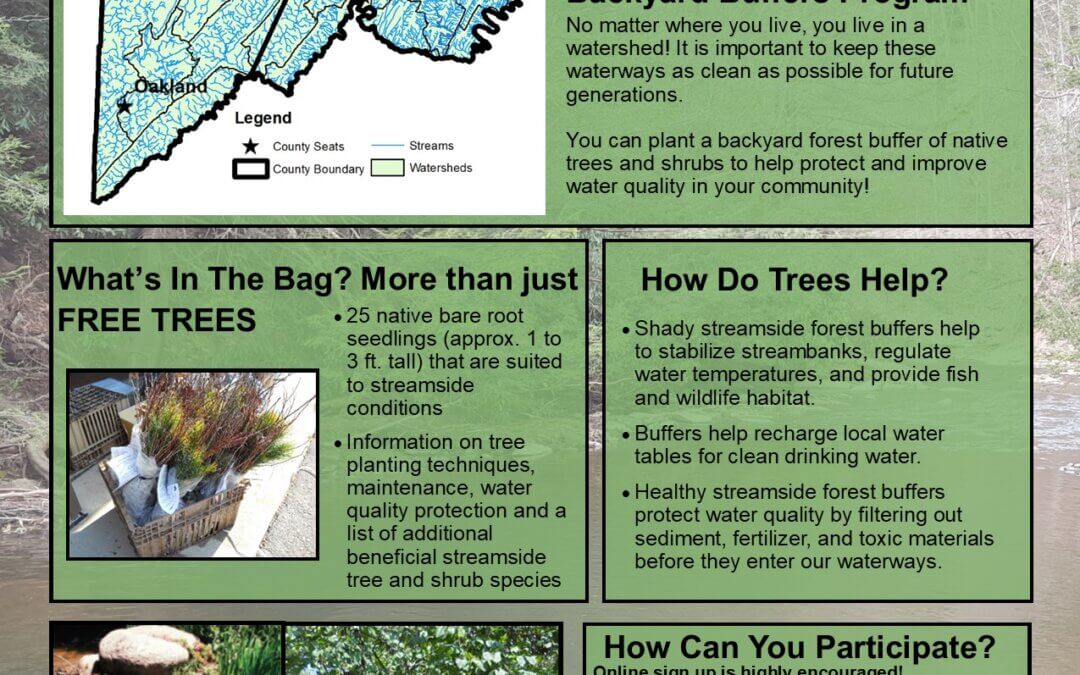
Mar 7, 2023
Allegany & Garrett County Backyard Buffer Program 2023
Backyard Buffers is a program of the Maryland Forestry Service and is open to anyone with a stream, pond, drainage ditch or other wet area on their property where they would like to plant trees.
Packets of 25 bare-root seedlings are provided at no cost! This year’s packets will include white pine, pin oak, American plum, silver maple and hazelnut (5 of each). Anyone interested can apply here:
Complete THIS FORM.
Reservations are being accepted until March 17th or until the program fills. A limited number of trees are available and it is possible the program may reach capacity before this date. Anyone who signs up after the program fills will be placed on a wait list. Those who qualify will receive additional information on where and when to pick up your trees in late March. Pickup will be set for mid-April (yet to be determined depending on when trees arrive from the nursery). Please add melissa.nash@maryland.gov and adam.miller@maryland.gov to your email contacts to avoid communications going into spam folders. We will send you a brief follow-up survey in the fall.
We have additional options if you have a larger area you wish to plant (1 acre or more) and funding is available for larger plantings! If you are interested in such an opportunity please contact Melissa (Garrett County) or Adam (Allegany County) at the email addresses above or answer “yes” to the last question on this form and we will be happy to contact you!
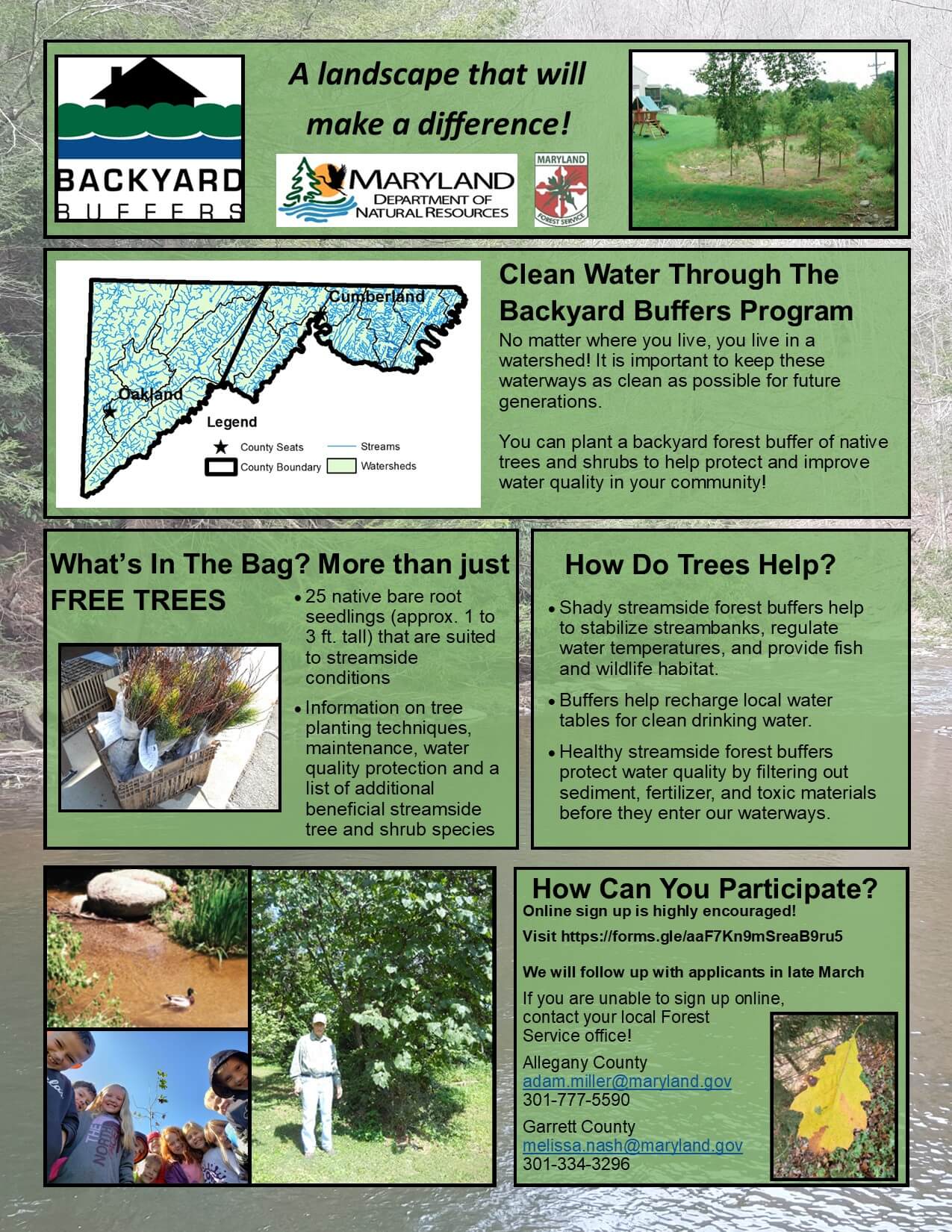
Feb 24, 2023
Garrett County Public Schools (GCPS) has set dates for the Route 40 and Swan Meadow school closure advisory presentations and public hearings. Each School Closure Advisory Committee will present to the Superintendent of Schools and the Board of Education, then make its recommendation on the future status of its respective school.
Route 40 Elementary’s meeting will take place on Wednesday, March 8, 2023, beginning at 6:00 p.m., in the school cafeteria.
Swan Meadow School’s meeting will take place on Thursday, March 9, 2023, beginning at 6:00 p.m., at the Pleasant Valley Community Center.
Also, as announced during the February Board Meeting, Garrett County Public Schools (GCPS) will facilitate a Blueprint Community Information Session on Wednesday, March 1, 2023. The session will take place from 6:00-7:30 p.m. in Room 111 of the GEIC Building, located on the Garrett College campus. The purpose of the session is to share information with the community regarding the GCPS Initial Blueprint Implementation Plan. This will also be an opportunity for stakeholders to share feedback specific to the GCPS plan. All five pillars of Blueprint will be discussed. All are welcome and encouraged to attend.

Feb 9, 2023
Garrett County has some of, arguably, the best bike riding in the country. I make it a point to ride year-round and it’s always a great time.
If there’s snow, there are no problems. Just a few inches of snow will freeze the ground and most mountain bikes can handle a little bit snow. There might be some slipping and sliding but it’s about being outside and breathing the fresh air! Plan on a short ride because if you’re pushing through the snow on your bike it can get tiring.
If there’s more than a few inches of snow, we will try to ride fat bikes where it’s groomed. I know Herrington Manor State Park will groom their trails when there is about 6 inches of snow or more. The Deep Creek Lake Lion’s Club Park will also groom as conditions allow. Lastly, there is another local park that does do some grooming but I advise you to stay away from it if you’re looking to bike: New Germany State Park. New Germany park is what I call “ski-first” and those trails are excellent cross-country ski trails. When they groom or set ski tracks, personally, I want to ensure the mountain or fat bikes don’t mess up those tracks.
That said, it’s important to note that all Maryland State Parks are multi-use trails so hikers, bikers, skiers, and equestrians have to get along on any trail. And no motorized vehicles — including ebikes — are allowed on Maryland State property unless otherwise noted. Of course, this is at the time of this writing in February 2023 and I hope to update this in the future.
Lastly, the most important thing to keep in mind when trail riding in the winter is to watch out for the freeze-thaw cycle. If you set out on a trail and find it to be muddy and wet, you could be interrupting the ground’s natural trail rejuvenator. In the winter, moisture in the ground expands as it freezes, so at least the top layer of the dirt is loosened up. If you go riding through this layer of loose dirt, you are doing significant damage to the trails.
When winter riding, make sure the ground is completely dry or completely frozen solid. “If you leave a track, turn back”
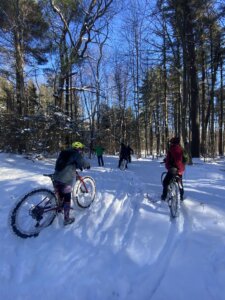
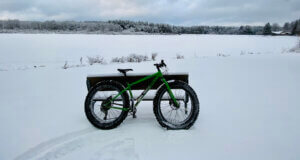

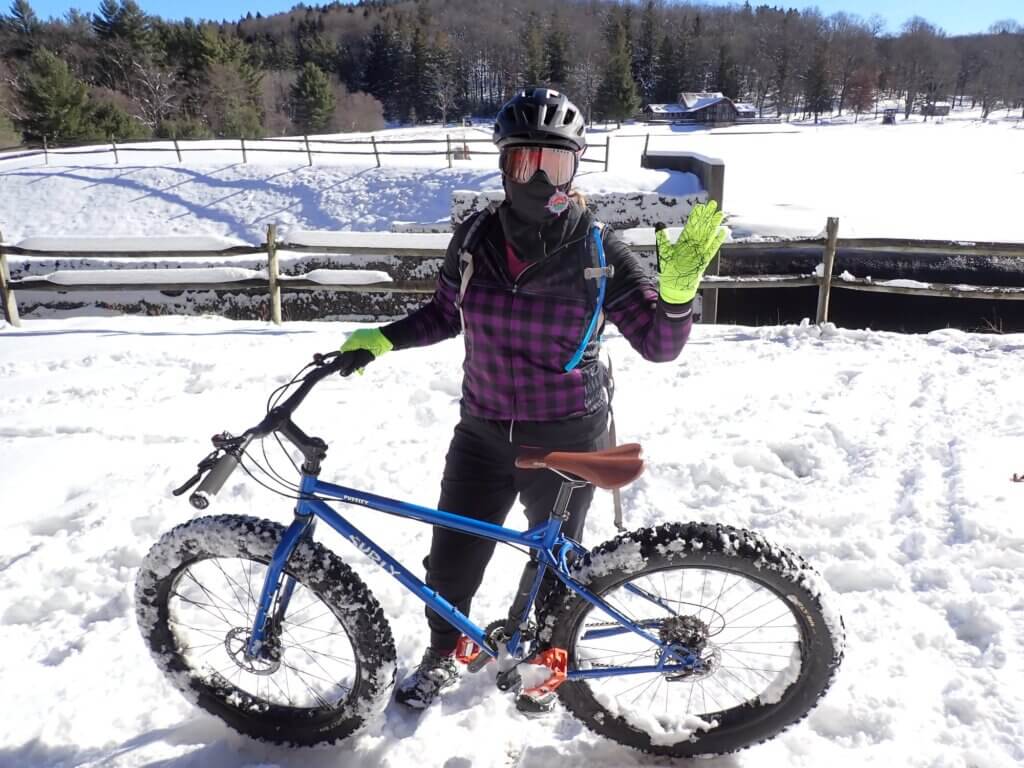
Feb 3, 2023
The Fairfax Stone is a surveyor’s marker to note the boundary between Maryland and West Virginia.
Originally used in the 1700s to settle a dispute over land in the English colonies of Maryland and Virginia, this stone is one of the oldest markers in the United States.
According to this historical account, “over the years, the stone has been changed out for various reasons. The current Fairfax Stone, the fifth, was dedicated as a state historic monument and became part of the West Virginia State Park system in 1957 when the Western Maryland Railroad gave four acres of land surrounding the stone to the state. In 1970, the stone was listed on the National Register of Historic Places.”
The marker itself reads:
“This monument at the headspring of the Potomac River marks one of the historic spots of America. It’s name is derived from Thomas Lord Fairfax who owned all the land lying between the Potomac and Rappahannock Rivers. The first Fairfax stone marked “FX”, was set in 1746 by Thomas Lewis a surveyor employed by Lord Fairfax. This is the base point for the Western dividing line between Maryland and West Virginia.”
The Fairfax Stone marker is within a four-acre West Virginia State Park where no overnight accommodations are available.

Feb 3, 2023
Typically, 5% of any given tree is made up of leaves, 15% of the tree is made up of the stems, 60% of the tree is made up of the trunk, and 20% of the tree is made up of roots. Because of a process called photosynthesis, trees are able to remove pollutants from the air such as ozone, carbon monoxide, nitrogen dioxide, and sulfur dioxide.
According to the Nature Conservancy, “smarter management of trees, plants, and soil in the U.S. alone could store the equivalent carbon of taking 57 million cars off the road”. Since older, larger trees store a lot more carbon than young trees, conserving and protecting the largest trees is a top priority.
In 1925, the Big Tree Program began in the state of Maryland. The program serves to reward owners of big trees, provide a baseline for scientific studies, show trends for big tree distribution, and provide locations for rare and unusual tree species.
The program is managed by a volunteer group called the Maryland State Association of Forest Conservancy District Board and is mostly funded by the U.S. Department of Agriculture Forest Service for Urban and Community Programming. Partial funding is provided by grants from the Chesapeake Bay Trust.
Fred Besley, Maryland’s first forester, developed the formula used today to measure trees:
Circumference in inches + Height in feet + ¼ of the average crown spread = TOTAL POINTS
Garrett County is home to a list of big trees and the big tree website provides information on the active trees in the database. There are also legacy, deceased, and inactive trees from Garrett County found on this website.
Jan 30, 2023
Canaan Valley is a region in neighboring West Virginia. It’s about a 50-minute drive from Oakland, Maryland.
You’ll set off South on Route 219, through Oakland and Red House to West Virginia.
Pass the turnoff for the Fairfax Stone marker.
Stay straight and get on Route 32. Pass the quaint town of Thomas, WV.
Continue on and pass the adjacent Davis, WV.
Then, seemingly, the tree cover will open at once and you’ll see the beautiful Canaan Valley. I pronounce it KI – NAYNE. Or, feel free to use the Hebrew pronunciation of k’naan or ki-na’an. The origin is “land of promise”.
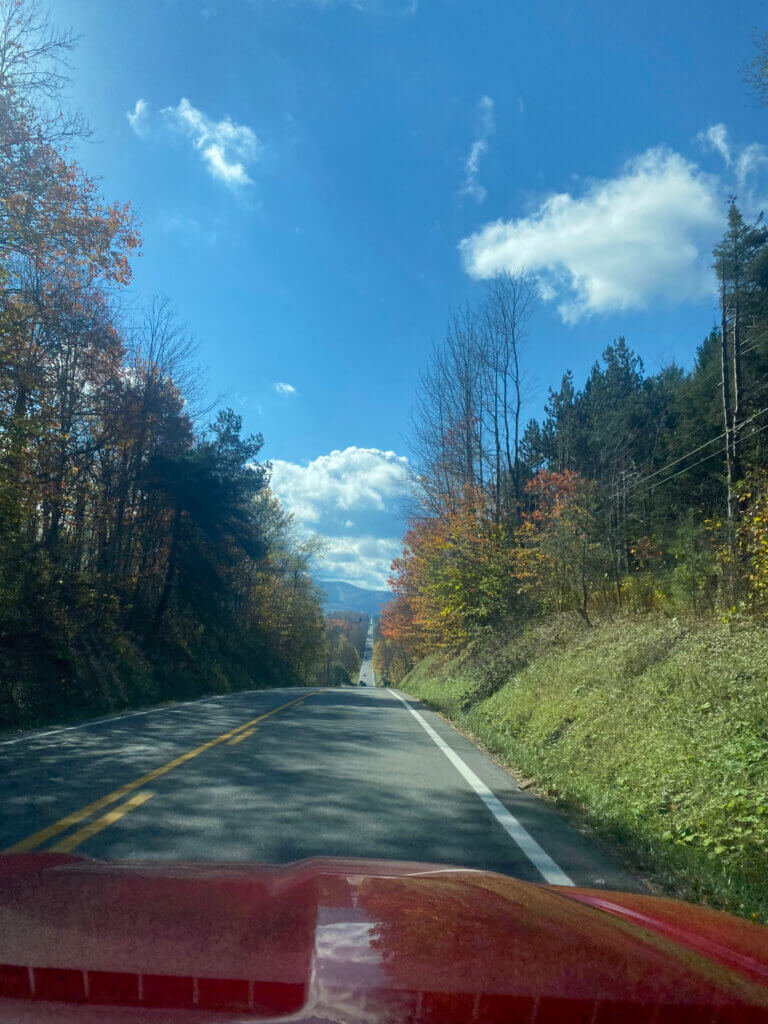
This hidden gem is home to a great day-trip full of outdoor activities. Canaan Valley Resort State Park offers skiing, snowboarding and snow tubing in the winter and hiking, biking, golfing, and camping in the summer. There’s an outdoor swimming pool and bicycling pump track, too.
Even if the adventure activities aren’t your cup of tea, it’s worth the drive to take in the sights, watch the hundreds of deer meander, and enjoy a literal cup of tea in the Lodge.
Also, about 70% of the Valley has become the Canaan Valley National Wildlife Refuge, the nation’s 500th National Wildlife Refuge.
If you’re looking for something to do, I’ve had some good times gliding across the snow farm at Whitegrass and hanging out a Trail Labs.
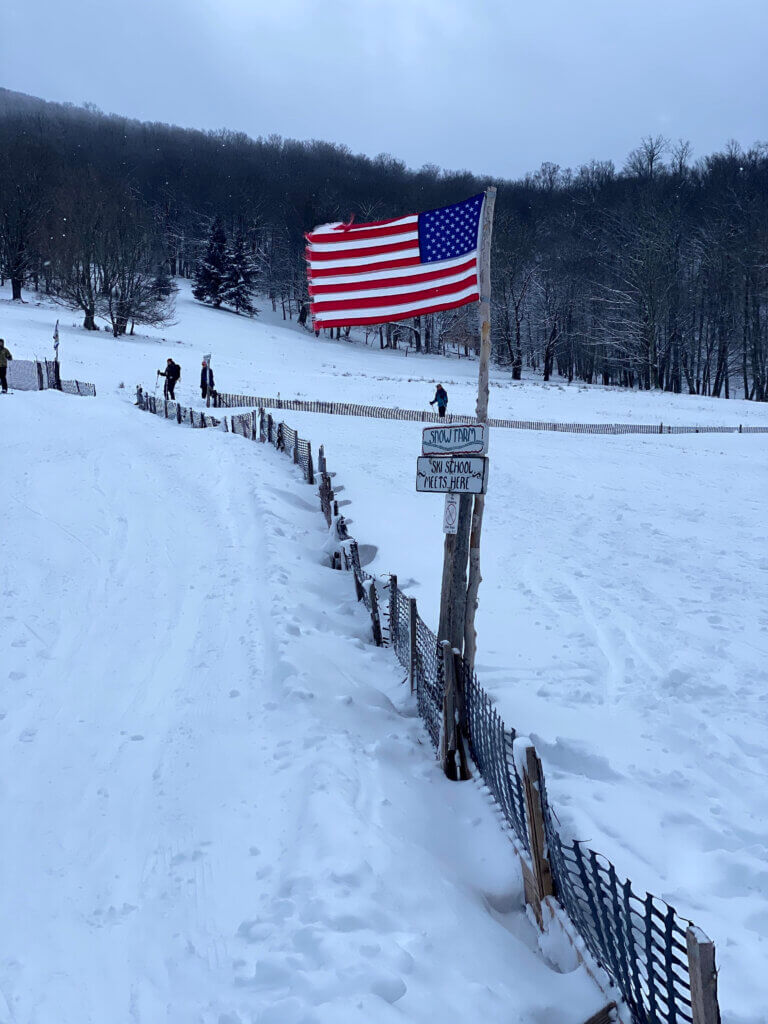

Dec 23, 2022
Non-Profit and Community Organizations in Garrett County and Deep Creek Lake, Maryland
(organizations linked as partners and/or on information available)
AHEC West – https://ahecwest.org/
Garrett County Volunteer Fire Departments and EMS – https://agcvfra.net/
Appalachian Crossroads – https://www.appalachiancrossroads.com/
AAUW – https://garrettcounty-md.aauw.net/
Barn Quilt Association of Garrett County – https://garrettbarnquilts.org/
Believe in Tomorrow Children’s Foundation – https://www.believeintomorrow.org/
Broken Road Associates – https://brokenroadassociates.org/
Christian Crossing Thrift Shop – https://christiancrossing.net/
Cindy’s Fund – https://cindysfund.org/
Country Fest and Auction – https://www.facebook.com/countryfestandauction/
Crossroads Church – https://crossroadsthechurch.com/
Civic Club of Oakland – https://civicclubofoaklandmd.com/
County United Way, Inc. – https://cuw.org/
Cub Scout Pack 6460 (McHenry, MD) – https://www.facebook.com/groups/852530194799275/
Deep Creek Lake Lions Club
Deep Creek Lake Property Owners Association
Deep Creek Watershed Foundation
Dove Center – https://www.gcdovecenter.org/
Engage Mountain Maryland – https://www.engagemmd.org/
Evergreen Heritage Center Foundation – https://evergreenheritagecenter.org/
GACo Inc – https://www.facebook.com/frc1629/
Garrett County Arts & Entertainment District – https://garrettarts.org/arts-entertainment-districts/
Garrett County Arts Council – https://garrettarts.org/
Garrett County Broadband – https://www.garrettcounty.org/broadband
Garrett County Board of Realtors – https://gcbr.org/
Garrett County Celtic Festival – https://gccelticfestival.com/
Garrett County Community Action – https://www.garrettcac.org/
Garrett County Habitat for Humanity – https://garrettcountyhabitat.org/
Garrett County Health Department – https://garretthealth.org/
Garrett County Historical Society – https://garrettcountymuseums.com/
Garrett County Humane Society – https://www.facebook.com/GarrettCountyHumaneSociety/
Garrett County Lighthouse, Inc. – https://www.garrettcountylighthouse.org/
Garrett County Public Schools – https://www.gcps.net/
Garrett Choral Society
Garrett College Foundation – https://www.garrettcollege.edu/foundation.php
Garrett Community Concert Band
Greater Garrett County Youth Lacrosse Club – https://www.facebook.com/GarrettCountyAreaYouthLax/
Garrett Growers – https://www.garrettgrowers.com/
Garrett Lakes Arts Festival (GLAF)
Garrett Mentors – https://garrettmentors.org/
Garrett Trails – https://www.garretttrails.org/
Grantsville Lion’s Club – https://www.facebook.com/GrantsvilleLions/
Greater Grantsville Business Association – https://www.visitgrantsville.com/businesses/ggba/
Greater Oakland Business Association – https://oaklandmd.com/business.html
HART for Animals
House of Hope – https://houseofhopegc.org/
Hospice of Garrett County – https://hospiceofgc.org/
Junior Woman’s Civic Club (JWCC) of Garrett County – https://jwccgarrettcounty.weebly.com/
Kitzmiller Lion’s Club – https://www.e-clubhouse.org/sites/kitzmillermd/
Landon’s Library – https://landonslibrary.org/
Let’s Drive (by Garrett County Community Action) – https://form.jotform.com/223164587526159
Loar Auxiliary Gift Shop
Marine Corps League Garrett County Detachment 1234 – https://garrettmarines.org/
Maryland Off-Highway Vehicle Alliance – http://www.mdohvalliance.org/
Maryland 4-H Environmental Education Center – https://extension.umd.edu/programs/4-h-youth-development/program-areas/environmental-sciences/maryland-4-h-environmental-education-camping-center
Maryland Salem Children’s Trust – https://mdsalem.org/
Mountain Maryland Gateway to the West Heritage Area – https://www.garrettheritage.com/
Mountain Laurel Garden Club – https://www.mountainlaurelgardenclub.com/
Mountaintop Soccer Association – https://www.mountaintopsoccer.org/
National Interscholastic Cycling Association
Oakland Mt Lake Park Lions Club – https://e-clubhouse.org/sites/oaklandmlp/index.php
Our Town Theatre – https://www.ourtowntheatre.org/
Penn Alps Restaurant & Craft Shop
Reflection House – https://www.reflectionhousegc.org/
Relay for Life of Garrett County United – https://www.facebook.com/garrettmdrelay/
Rotary Club of Oakland – https://www.facebook.com/profile.php?id=100066218636275
Ruth Enlow Library – https://www.relib.net/
Special Olympics Maryland – Garrett County – https://www.facebook.com/somdga/
Theatre on the Lake (TOTL) – https://www.totltheatre.org/
Youghiogheny Glades Chapter NSDAR – https://youghioghenyglades.marylanddar.org/























